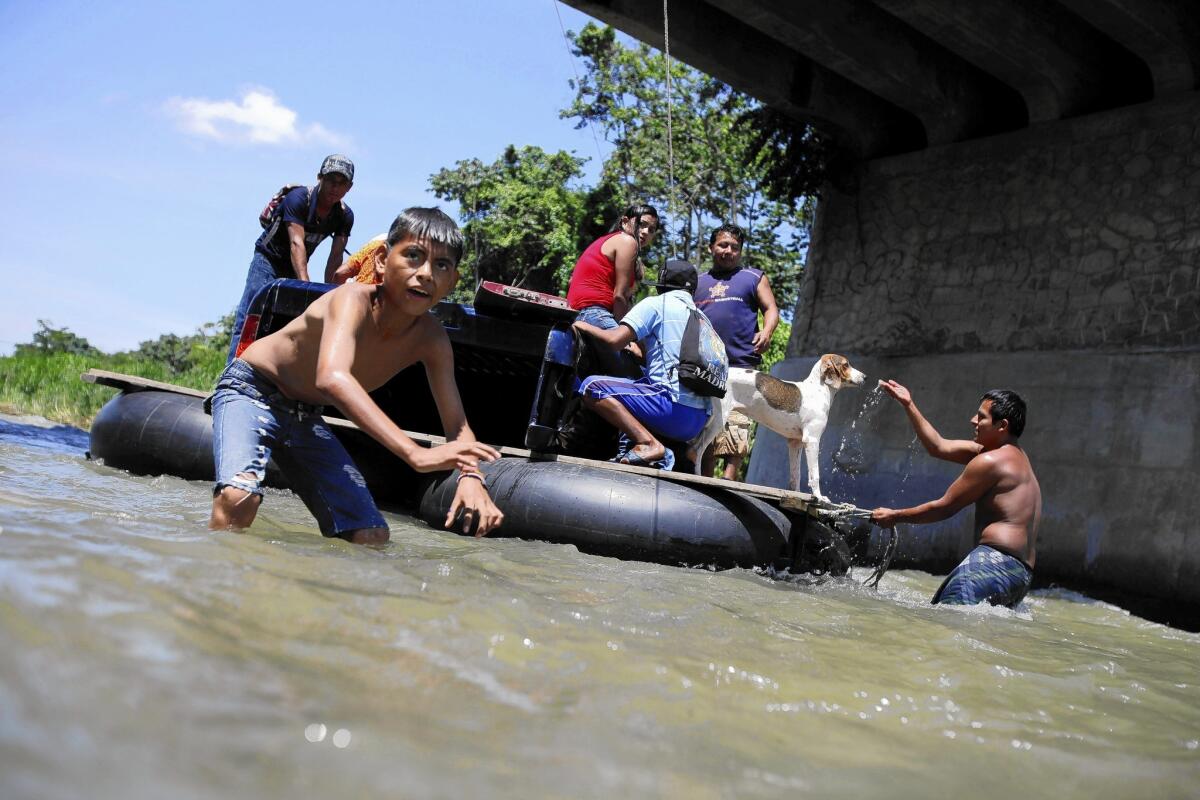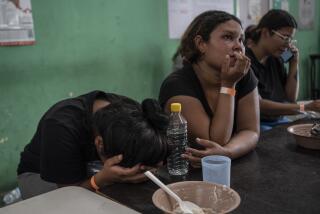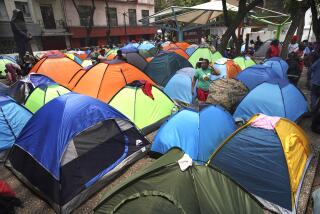More than rumors drive Central American youths toward U.S.

- Share via
Reporting from Horcones, Guatemala — A couple of weeks ago, sisters Karen and Sindy Laucel joined the exodus of youths from Central America, hoping to reconnect with their mother, who had left this farming village a decade ago in search of work in the U.S.
With so many heading north, now seemed the time to reunite. The teens filled a single backpack with three days’ worth of clothes, and their mother paid a coyote, or guide, to take her daughters and a 10-year-old girl from the village to the U.S. border nearly 2,000 miles away.
Crossing the Suchiate River into Mexico on an inner tube and traveling mostly by bus, they seemed to be among the lucky ones. They avoided the extortion, rape and other crimes so prevalent along the route — up until the moment an immigration agent pulled them from a bus in central Mexico.
Held for a week in a shelter near Mexico City with dozens of other girls and boys, they ate pizza and watched telenovelas until they were dispatched back home.
“I cried and cried and cried,” said Karen, 15. “Only when I finally saw all the other girls did I calm down.”
Sindy, a year older, has memorized her mother’s phone number in North Carolina, and said she just wanted to get to know her.
“I know her only by photos,” Sindy said.
Some Central Americans feel encouraged by rumors that children who cross into the United States will be allowed to stay. But other fundamental reasons fueling migration have remained unchanged for decades: family unification, hometown violence, inescapable poverty and lack of opportunity.
Guatemala, Honduras and El Salvador, the so-called Northern Triangle of Central America, are among the poorest and most dangerous countries in the hemisphere. Plagued by ruthless street gangs and a growing presence of Mexican drug traffickers, the countries have seen homicide rates grow by 99% over the last decade, with the current rate five times that of the United States, according to a new study by the British-based Action on Armed Violence.
Karen and Sindy’s father and grandfather were shot to death in unsolved killings. The family can no longer afford to pay for Sindy’s schooling. The town where they live, Horcones, in Jutiapa state near the border with El Salvador, can’t pay its electricity or water bills to the federal government.
The homes, by contrast, reflect the wealth of remittances, money sent back by those who have migrated to the U.S. Many are well-constructed, with solid sheet-metal roofs and fancy Greek-style columns. In the Laucel house, the kitchen has a sparkling new Whirlpool refrigerator, although it is nearly empty, and a matching four-burner range, which is not plugged in. But the money arrives sporadically and lends itself to big-ticket purchases rather than steady sustenance.
Karen and Sindy’s mother, Mirna, is one of five siblings; all but one are in the Southeastern United States, sending money home and frequently calling the children they left behind. Mirna has never been back to visit.
The Obama administration says it detained more than 50,000 “unaccompanied minors” trying to cross the border in the first half of this year.
In fact, the smuggling of people to the U.S. is big business. Coyotes, who in Mexico are often descendants of some of the country’s most vicious drug cartels, can charge $7,000 or more for a single migrant. These networks may in fact be stimulating the current exodus by lying about the difficulties of the journey and giving false promises about what lies ahead, experts say.
“The majority of parents are there [in the U.S.] and they are asking for their children to join them,” said Merlin Palma, a homemaker and mother of two waiting her turn at the Horcones beauty salon. “Coyotes take them, but it’s dangerous. They promise you a thousand things, but on the way it’s different. The kids suffer.”
The United States has repeatedly asked Mexico to take stronger steps to block passage by Central Americans heading toward the U.S. border, but enforcement has been spotty. The Mexican immigration department says the number of minors apprehended has increased by about 7% this year.
Those making the journey often try to pass themselves off as Mexicans, learning the vernacular and wearing fancy sunglasses.
In El Carmen, a Guatemalan city on the border with Mexico, scores of adults and children were arriving in buses one day last week and hurrying over to rafts waiting to take them across the river.
The route was under the same bridge where Mexican immigration authorities were posted. The migrants would land a few feet away and scramble up a bank, largely undetected — perhaps deliberately — by the agents.
Farther inland in Quetzaltenango, at a government-run shelter for deported minors, about 40 youngsters were being held the other day, waiting for relatives who must present a birth certificate to pick them up. Authorities queried the relatives about why the children had left home, and showed the relatives films about the horrors that befall migrants trying to cross Mexico.
Among the relatives was Soila Salazar, Karen and Sindy’s grandmother, who was relieved to see them. “I was desperate when they left, so worried,” she said. “But there are so many problems here.”
Ludvin Lima Gonzalez, 15, was there as well, waiting for his mother, Aura.
Back home a couple of days later in Nueva Concepcion, in the gang-terrorized state of Escuintla, south of Guatemala City, Ludvin said he wanted to go north to help his impoverished family. He has 10 siblings, ages 7 to 32, and a sick father who can’t work. The family lives off meager corn crops.
“It’s very dangerous here,” Ludvin said under the almond trees shading his home’s dirt patio, his father languishing in a hammock.
Some of his friends have been killed for refusing to join the gangs, and members of the family could tick off a series of recent slayings. “You look at them the wrong way and they kill you,” Ludvin said.
“It is painful” to see a child leave, said Aura Gonzalez, 49. “You ask God to protect them. But that’s the necessity.”
As in neighboring El Salvador and Honduras, street gangs — some whose roots are in Los Angeles — have occupied large parts of Guatemala. The three countries have been trying to recover from civil wars and other conflict in the 1980s and ‘90s.
The choice for children is bleak, said the Rev. Gerardo Salazar, a priest in the Nueva Concepcion parish.
“You dedicate yourself to drugs and violence, or you grab the road to the United States, as complicated as that is,” he said.
At every Sunday Mass, Salazar said, he is asked to pray for young people killed in town, where about $12 is all it takes to hire an assassin.
Back in Horcones, Sindy and Karen arrived home on Saturday. They went straight to their rooms, where all their belongings were packed in boxes, since they hadn’t been expected to come back.
Karen, thin and compact, seemed withdrawn, reluctant to talk much. Sindy, her full face surrounded by a bouquet of dark curls, vacillated between chatterbox and shy teenager.
Sindy said the camaraderie of the other children tempered her fear on the perilous journey through Mexico.
“I was going along happy, with all the other kids, and thinking I was finally going to get to know my mom,” she said. She said she was told to surrender to U.S. immigration officials when she reached that border and that all would be well. But she didn’t get that far.
She thought perhaps the Mexican immigration authorities zeroed in on her because she was “shaking so much.” Most of the other minors were Honduran; she, her sister and the 10-year-old were the only Guatemalans on the bus.
Now, back home, all she wanted was to take a bath and to sleep. And then, maybe, to try again.
“I don’t want to give up,” Sindy said.
Times staff photographer Michael Robinson Chavez in El Carmen and special correspondent Anna Bevan in Quetzaltenango contributed to this report.
More to Read
Sign up for Essential California
The most important California stories and recommendations in your inbox every morning.
You may occasionally receive promotional content from the Los Angeles Times.











